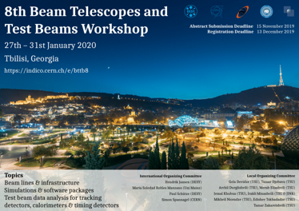Speakers
Description
During the first run (2015-2018), the Proton Irradiation Facility (IRRAD) in the PS East Area, and the Gamma Irradiation Facility (GIF++) in the SPS North Area at CERN provided an essential service for performing irradiation experiments on detector & accelerator elements, electronic components and materials.
In IRRAD, the primary 24 GeV/c proton beam of the PS is extracted to the T8 beamline in spills of ~5×10^11 p and it has been optimized for testing inner particle detector components. During the CERN Long Shutdown 2 (LS2), the IRRAD facility will undergo several upgrades in order to cope with the increasing demand for irradiation experiments required for the HL-LHC. In this presentation we describe: (1) the key modifications to the IRRAD beamline and infrastructure that will be implemented during 2020, (2) the last features implemented to the IRRAD Data Manager System (IDM) used to follow up the irradiation experiments, as well as (3) the results of new ultra-thin Beam Profile Monitor (BPM) devices, the main beam instrumentation of IRRAD. Finally, the results of calibration measurements performed with Xe and Pb Heavy Ion beams in 2017 and 2018 will be also presented.
GIF++ is a mixed photon/muon irradiation facility originally designed for the needs of the community working with muon gas detectors, now hosting a big variety of different test setups. GIF++ provides a 14 TBq Cs-137 source throughout the year, combined with a muon beam (from EHN1-H4 beamline) for several weeks per year. As IRRAD, GIF++ was constantly overbooked since its first run, with the main limitations being the large size of the detectors and the space available inside the irradiation bunker. During LS2, the workload of the facility has even increased because of several mass-production tests. In this presentation, we describe the various upgrades to the facility – including a >50m^2 extension of the irradiation area carried out in summer 2019 - plans to enhance the muon beam intensity and availability, as well as the ongoing upgrades of the detector infrastructure available to the users from LS2 onward.
